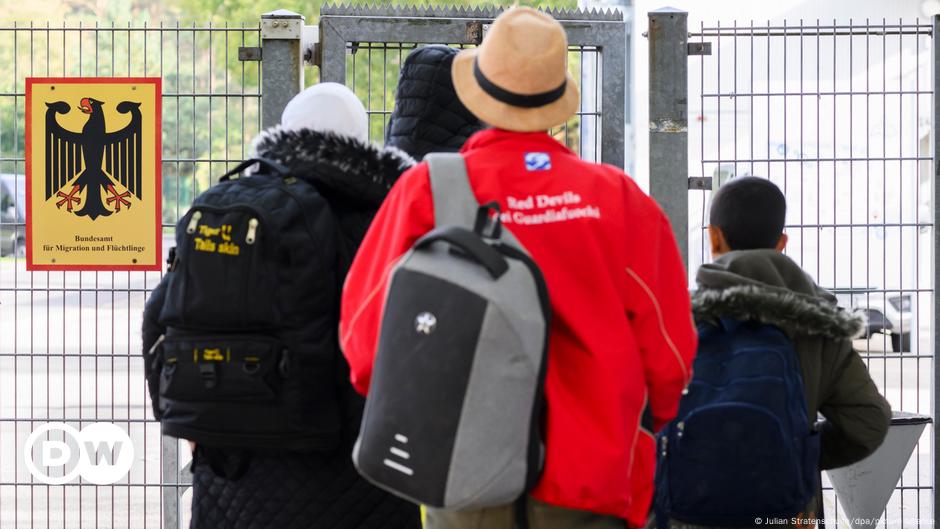Ursula von der Leyen and Olaf Scholz are seeking a “Europe-wide strategy” Image: Ebrahim Noroozi/AP/picture alliance/dpa
Hungary, Netherlands and Poland opposed
At least three EU member states object to the bloc’s current approach. And two of them — Hungary and the Netherlands — are even demanding a complete opt-out from EU asylum policy. Both say they have no intention of going along with the latest reforms. They have now been joined by Poland, whose Christian Democrat Prime Minister Donald Tusk says he wants to temporarily suspend EU laws on asylum-seekers. He says Poland is facing an emergency situation.
The European Commissioner for Home Affairs, Ylva Johansson, is unimpressed by the threats to ignore European law. “It is not possible according to the EU treaty and I have said that,” she said, pointing out that such a move would require agreements to be re-written, which is not currently on the agenda. Germany’s Interior Minister Nancy Faeser also dismissed the threat, describing it simply as “not a good idea.”
Hungary, Italy and Finland forging own paths
Meanwhile, some EU member states are going their own way, even without a formal “opt-out.” Hungary has been refusing to apply EU asylum law for years, even ignoring numerous rulings on the matter from the European Court of Justice. The European Commission is now trying to force Hungary to pay fines of €200 million (ca. $218 million), in the hope that this will persuade Prime Minister Viktor Orban’s government to toe the line. But Orban has already rejected the planned reforms and said that Hungary will no longer accept any asylum-seekers.
Similarly, the Italian government of far-right Prime Minister Giorgia Meloni is also ignoring EU laws, refusing to take back from Germany or Austria any migrants who first arrived in Italy. Under what’s known as the “Dublin Regulation,” Italy is obliged to register migrants and open an asylum procedure for them. But many people who arrive in Italy quickly travel further north. The same is true for people arriving in Greece, on the EU’s southeastern border, many of whom take what has become known as the Balkan route to EU member states in the north – something that is not meant to happen according to the Dublin Regulation.
Italy, Greece and other countries on the EU’s external borders argue that they are overwhelmed by the sheer numbers of migrants arriving.
In an attempt to stop people travelling on within the EU, France, Austria, Denmark, Sweden, Slovakia, and now Germany, have re-introduced checks at their borders. That, too, is undermining EU policy, which theoretically only allow controls at internal borders under exceptional circumstances.
There are also other examples. Finland is prepared to ignore EU law at its border with Russia, if migrants will arrive in great numbers. Migrants would not be able to apply for asylum, but would be send back to Russia instead. The new law has not been applied so far. However, Finnish Prime Minister Petteri Orpo said in July that the move was necessary, even though it stands in direct contravention to Finland’s international human rights obligations. Finland, the Baltic states and Poland all accuse Russia and Belarus of sending huge numbers of migrants to the EU’s borders with the express aim of destabilizing the bloc. Prime Minister Tusk has said he wants to follow Finland’s lead and close Poland’s border to Belarus for all asylum-seekers.
Poland wants to shut its border with Belarus to prevent migrants from coming into the EUImage: Maciej Luczniewski/NurPhoto/picture alliance
Outsourcing asylum procedure
Ursula von der Leyen made a series of proposals in a letter to EU leaders ahead of the summit. She wants to improve cooperation with designated “safe third countries” where migrants could potentially be housed until their asylum applications have been processed. The British government tried something along those lines in a deal with Rwanda, but without any real success.
In the meantime, Italy has established an asylum center in Albania. The idea is for migrants to be held there while their asylum application is heard under Italian law. Once a decision has been reached, the migrants can either return to Italy or be deported back to their home countries from Albania. But EU diplomatic sources say the European Commission is not yet convinced that this is a good model for the bloc as a whole.
Ceuta: Spain’s North African exclave sees migration surge
To view this video please enable JavaScript, and consider upgrading to a web browser that supports HTML5 video
Migration routes changing
The number of migrants arriving in Italy from northern Africa has fallen significantly this year. Some 42,000 people came to Italy between January and August — 64% less than the same period last year. The European Commission says that’s down to better cooperation with two of the main transit countries, Tunisia and Libya.
But at the same time, the number of migrants arriving in Europe via the Mediterranean and Atlantic route doubled in the same period to 25,500. And the numbers reaching Greece and Cyprus via the eastern Mediterranean are also climbing — up 39% to 37,700 between January and August 2024.
This article was translated from German.
Source link : https://www.dw.com/en/eu-seeks-to-accelerate-return-of-migrants/a-70513978
Author :
Publish date : 2024-10-16 21:20:00
Copyright for syndicated content belongs to the linked Source.
